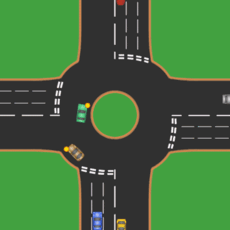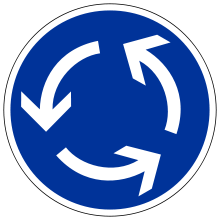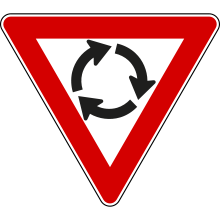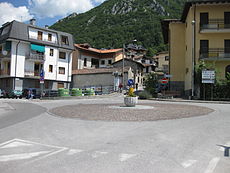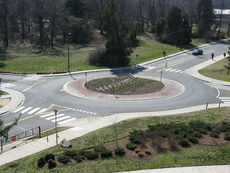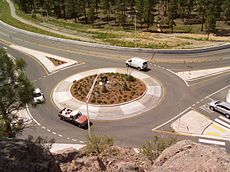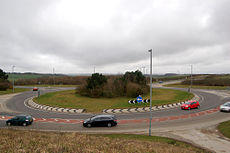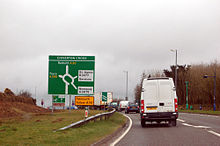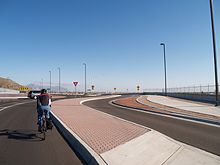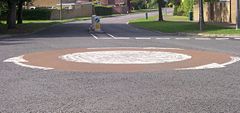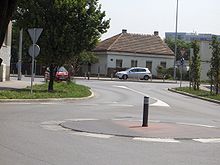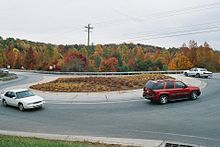- Roundabout
-
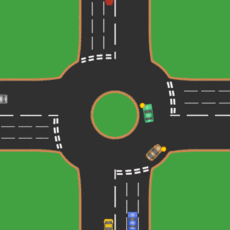 Movement within a roundabout in a country where traffic drives on the right. Note the anticlockwise circulation.
Movement within a roundabout in a country where traffic drives on the right. Note the anticlockwise circulation.
A roundabout is the name for a road junction in which traffic moves in one direction around a central island.[1] The word dates from the early 20th century.[1] Roundabouts are common in many countries around the world. It is similar to traffic circles that are primarily found in the United States, except that in a roundabout entering traffic must always yield to traffic already in the circle, whereas in a traffic circle entering traffic is either controlled by stop signs, traffic signals, or is not formally controlled at all.[2]
Contents
History
Numerous circular junctions existed before the advent of roundabouts, including the 1907 Place de l'Etoile around the Arc de Triomphe in Paris, the 1904 Columbus Circle in New York City, and several circles within Washington, DC. However, the operating and entry characteristics of these circles differed considerably from modern roundabouts.[citation needed] The first British roundabout was built in Letchworth Garden City in 1903, making it the first in the world. It was originally intended partly as a traffic island for pedestrians.[3][4] In the early 20th century, numerous traffic circle junctions were constructed in the United States, particularly in the northeast states. There are many instances of traffic circles in the US that predate the modern roundabout, like the ones that can be found in Atherton California.[5]
At the beginning of the 21st century, roundabouts are in widespread use in Europe. France, for instance, had more than 30,000 roundabouts in 2010.[6]
Modern roundabout
A "modern roundabout" is a type of circular junction that was developed by the UK's Transport Research Laboratory[citation needed] in the mid twentieth century,[citation needed] in which road traffic must travel in one direction around a central island and priority is given to the circulating flow. Signs usually direct traffic entering the circle to slow down and give the right of way.[7]
These junctions are called "modern roundabouts" in order to emphasise the distinction from older circular junction types which had different design characteristics and rules of operation.[citation needed] Older designs, called "traffic circles" or "rotaries", are typically larger, operate at higher speeds, and often give priority to entering traffic.[7] In some cases, the term "traffic circle" has been used to describe roundabouts in North America. The originally British term "roundabout" is now often [7] used in North America too by officials and engineers, but it remains rare in general US usage though commonplace elsewhere.[8][9]
In countries where vehicles keep to the right, the traffic flow around the central island of a roundabout is anti- (or counter-) clockwise; where they keep to the left, it is clockwise.
Statistically, roundabouts are safer for drivers and pedestrians than both traffic circles and intersections.[10] Because low speeds are required for traffic entering roundabouts they are usually not used on controlled-access highways but may be used on lower grades of highway such as limited-access roads. When such roads are redesigned to take advantage of roundabout principles, steps are taken to reduce the speed of traffic, such as curving the approaches.
Modern roundabouts are common place throughout the world, in particularly Australia, Belgium, Canada, China, Costa Rica, Cyprus, Denmark, France, Germany, Hungary, Iceland, Ireland, Israel, Luxembourg, Malaysia, Morocco, the Netherlands, New Zealand, Portugal, Qatar, Spain, the United Arab Emirates, and the United Kingdom. Half of the world's roundabouts are in France (over 30,000 as of 2008).[11]
Difference from traffic circles
Following research by the Transport Research Laboratory, which found that circular junctions with certain geometric characteristics and traffic control schemes tended to be safer than those without them, the United Kingdom introduced the rule in 1966 that entering traffic must always give way to traffic already on the roundabout.[12]
Although the term roundabout is sometimes used for a traffic circle even in the United States, U.S. traffic engineers now make the distinction that in a roundabout entering traffic must always yield to traffic already in the circle, whereas in a traffic circle entering traffic is controlled by Stop signs, or is not formally controlled.[13] In their usage, circular junctions that have the following characteristics are roundabouts and those that do not are considered traffic circles:
- Roundabouts require entering drivers to give way to all traffic within the roundabout, regardless of lane position, while traffic circles typically allow traffic to enter alongside traffic circulating in an inner lane without consequence.
- Generally, exiting directly from the inner lane of a multi-lane roundabout is permitted, and such exiting traffic has the right-of-way over entering traffic. By contrast, exiting from the inner lane of a traffic circle is usually not permitted without first executing a lane change to the outside of the circle. Massachusetts, where older traffic circles, or rotaries, are commonplace, has a dwindling number of exceptions.
- Deflection on entry is used to maintain low speed operation in roundabouts. Drivers must manoeuvre (are deflected) around the splitter islands and the central island, at speeds of 15–25 miles per hour (24–40 km/h). Many older traffic circle junctions allow entry at higher speeds due to the lack of deflection, or require a stop and a 90-degree turn to enter, creating a large difference in speed between entering and circulating traffic which can make it difficult for entering drivers to find suitable gaps in heavy traffic.
- Pedestrians are usually prohibited from the central island of roundabouts, and the crosswalk for pedestrians and some cyclists is withdrawn from the junction by at least the length of one vehicle.
- All vehicles circulate around the central island of a roundabout in the same direction, which is determined by whether traffic drives to the right or the left. In left-hand traffic countries the circulation is clockwise; in those that drive to the right, it is anticlockwise.
- Modern multi-lane roundabouts are typically less than 250 feet (75 metres) in diameter,[14] although signalised roundabouts and roundabout interchanges may be considerably larger.
A large number of traffic circles have been converted to other types of junctions. Several have been converted to roundabouts, now meeting modern roundabout design standards, including the former Kingston traffic circle in New York and several in New Jersey.[15][16] Others have been converted to a series of signalised intersections, such as the Drum Hill Rotary in Chelmsford, Massachusetts, which is now six lanes wide, with traffic lights on all four corners. The formerly oval-shaped rotary is now smaller and round-shaped.
Terminology
In the U.S., many people use the terms "roundabout", "traffic circle", and "rotary" interchangeably, and they are defined as synonyms in dictionaries.[17] Many old traffic circles remain in the Northeastern United States. Since many of the older junction forms have unfavourable safety records, transportation professionals are careful to use "roundabout" when referring to newer designs and "traffic circle" or "rotary" when referring to ones that do not meet the criteria listed above.[citation needed]
The term "traffic circle" is not used in the United Kingdom, where most circular junctions meet the U.S. technical criteria for roundabouts. The U.K. does, however, have roundabout variants such as mini-roundabouts and magic-roundabouts — see below for the distinctions from the type of junction generally referred to here as a roundabout.e more precise term, modern roundabout is used often to differentiate more carefully.[citation needed]
Modern roundabout history
Although numerous circular junctions existed before the advent of modern roundabouts, the widespread use of the modern roundabout began[citation needed] when Transport Research Laboratory engineers re-engineered circular intersections during the 1960s and Frank Blackmore led the development of the offside priority rule and subsequently also invented the mini roundabout[18] to overcome its limitations of capacity and for safety issues. The rule was adopted as mandatory in Britain for all new roundabouts in November 1966. Unlike traffic circles, traffic approaching roundabouts is normally required to give priority to circulating and exiting traffic and to eliminate much of the driver confusion associated with traffic junctions and waiting queues associated with junctions that have traffic lights. Roughly the same size as signalled intersections with the same or sometimes a higher capacity, separate incoming and outgoing traffic with pedestrian islands to encourage slower and safer speeds (see traffic calming).
They were much less common in the United States, where they started seeing limited use in the 1990s and face some opposition from a population mostly unaccustomed to them. In 2011, there were about 3,000 U.S. roundabouts, and their number is growing steadily.[6][19] The first modern roundabout in the United States was constructed in Summerlin, Nevada in 1990. This roundabout occasioned a significant amount of "dismay" from residents, and a local news program several years later said about it, "Even police agree, they (roundabouts) can be confusing at times."[20] Roundabouts have since become increasingly common in North America. Carmel, Indiana has more than 77[21] roundabouts and hosted the 2011 Transportation Research Board's (TRB) National Roundabout Conference.[19][22]
Safety
File:002 Turner Lake Road roundabout in Covington, Georgia US.jpgRoundabouts are a replacement option for some existing intersections: roundabout at the intersection of Turner Lake Road and Clark Street in Covington, Georgia (note: roundabout signage)Roundabouts are safer than both traffic circles and junctions—having 40% fewer vehicle collisions, 80% fewer injuries and 90% fewer serious injuries and fatalities (according to a study[23] of a sampling of roundabouts in the United States, when compared with the junctions they replaced). Roundabouts also reduce points of conflict between pedestrians and motor vehicles and are therefore considered to be safer for them. However, roundabouts, especially larger ones with faster traffic, are unpopular with some cyclists. This problem is sometimes addressed at larger roundabouts by taking foot and bicycle traffic through a series of underpasses or alternate routes.
At traditional junctions with stop signs or traffic lights, the most serious accidents are right-angle, left-turn, or head-on collisions that can be severe because vehicles may be moving fast and collide at high angles of impact. Roundabouts virtually eliminate those types of crashes because vehicles all travel in the same direction and most crashes are glancing blows at low angles of impact.[24]
While roundabouts can reduce crashes overall compared to other junction types, crashes involving cyclists may not experience similar reductions. An analysis[25] of the New Zealand national crash database[26] for the period 1996–2000 shows that cyclists were involved in 26% of the reported injury crashes at roundabouts, compared to 6% at traffic signals and 13% at priority controlled junctions. The New Zealand researchers propose that low vehicle speeds, circulatory lane markings, and mountable centre aprons for trucks can improve the safety of cyclists within roundabouts.[27] These strategies are typically employed on modern roundabouts constructed in the United States.
The most common roundabout crash type for cyclists, according to the New Zealand study, involves a motor vehicle entering the roundabout and colliding with a cyclist who already is travelling around the roundabout (generally just over 50% of all cyclist/roundabout crashes fall into this category). The next most common crash type involves motorists leaving the roundabout, colliding with cyclists who are continuing further around the perimeter of the roundabout. Designs that have marked perimeter cycle lanes are found by research data to be even less safe than those without them, suggesting that in roundabouts cyclists should "take the lane", operating as a vehicle rather than tracking around the perimeter. The cure for this is applying the rule prohibiting overtaking and passing on the circular roadway to motor vehicles overtaking cyclists.[citation needed]
If the adjacent footpaths are not properly designed, there are increased risks for persons with visual impairments. This is because it is more difficult (than at a signalized intersection) to detect with hearing whether there is a gap in traffic adequate to cross. During the all-red interval at a signal, traffic comes to a stop, and blind pedestrians can tell by listening which direction gets the green light. Since there is often moving traffic at a roundabout, the sounds of non-conflicting traffic will mask gaps, or the sound of an idling vehicle whose driver has stopped to give way to the pedestrian.[28]
This issue has led to a conflict in the United States between the visually impaired and civil engineering communities; some in the visually impaired community have taken the position that roundabouts (rather than signal-controlled crossings) are acceptable only if there are pedestrian crossings with signalised control at each road connecting to a roundabout. Engineers point out that since vehicle speeds are slower, crossing gaps are more plentiful, drivers are more apt to give way, and pedestrian crashes are less severe than if the same driver had run a red light. However, the blind community considers this to be a civil rights issue, not an engineering issue. While pedestrian crossings with traffic lights installed in roundabouts exist (see below), signalisation is normally used on large-diameter roundabout interchanges rather than small-diameter modern roundabouts. Signalisation would also substantially increase the cost of roundabout construction and maintenance (essentially, both types of junction being built at every junction). Furthermore, equipping a roundabout with traffic-halting lights would decrease its throughput considerably, thereby artificially reducing or even eliminating the design's main advantage over traditional signal-equipped junctions. Signalisation would also increase delays for most pedestrians during light traffic, since pedestrians would need to wait for the signal to change to legally cross.[29]
Capacity and delays
The capacity of a roundabout varies based on the number of entry and circulating lanes, and also on more subtle geometry elements including entry angle and lane width. Also, like other types of junctions, the operational performance of a roundabout depends heavily on the flow volumes from various approaches. A single-lane roundabout can be expected to handle approximately 20,000 to 26,000 vehicles per day, while a two-lane roundabout can be expected to handle 40,000 to 50,000 vehicles per day.[30]
Under many traffic conditions, an unsignalised roundabout can operate with less delay to users than traffic signal control or all-way stop control. Unlike all-way stop intersections, a roundabout does not require a complete stop by all entering vehicles, which reduces both individual delay and delays resulting from vehicle queues. A roundabout can also operate much more efficiently than a signalised junction because drivers are able to proceed when traffic is clear without the delay incurred while waiting for the traffic signal to change.
However, roundabouts can increase delays in locations where traffic would otherwise not be required to stop. For example, at the junction of a high-volume and a low-volume road, traffic on the busier road would normally not have to stop if the junction were signalised, because the traffic signals would provide a green signal to the busier road the majority of the time. When the volumes on the approach roadways are relatively balanced, a roundabout can reduce delay because each approach would otherwise encounter a red signal greater than half of the time if the junction were signalised.
Roundabouts can also reduce delays for pedestrians when compared to traffic signals, because pedestrians are able to cross during any safe gap rather than waiting for the traffic signal to provide the right-of-way to the pedestrian. During peak hours of congestion when large gaps are infrequent, the very slow speed of traffic entering and leaving the roundabout can compensate for the smaller gaps and facilitate pedestrian crossings.
TRL, the UK's Transport Research Laboratory later developed a mathematical model throughout the 1960s and 1970s to facilitate traffic engineers with the necessary knowledge to engineer and design Roundabouts. It was decided by the UK government to deliver this in the form of 'Assessment of Roundabout Capacity And DelaY' (ARCADY). Several software packages now exist to help with calculating capacity and queues at roundabouts. These include ARCADY, RODEL and SIDRA INTERSECTION.
Roundabouts and cyclists
Cycle facilities at roundabouts
Research has shown that even in large circular junctions that lack modern roundabout design features, a high rate of bicycle/motor vehicle crashes occurs when bicyclists are riding around the outside. Design guidance for modern roundabouts recommends terminating cycle lanes well before the entrances, so bicyclists merge into the stream of motor traffic.[30][31]
A 1992 study[32] from the German Transport Ministry's research institute has cast particular light on this issue. The study found that bicyclists' risk is high in all such intersections, but it is much higher when the junction has a marked bicycle lane or sidepath around its outside (see "Marked perimeter cycle lanes" below). The results of this study concerning circular junctions are summarised on the web (in German, but partially translated below).[33] A report about accidents at four-arm roundabouts was published[34] by the UK Transport and Road Research Laboratory (TRRL) (now TRL) in 1984.
Collisions typically occur when a motorist is entering or leaving the circular roadway. A motorist entering the circular roadway must give way to traffic in it, but such traffic will generally keep away from the outside of the circular roadway (as with a vehicle in the photo) if passing an entrance. A bicyclist close to the edge of the roadway is not in the usual position where an entering motorist expects to look for circulating traffic.
When exiting the circular roadway, a motorist must look ahead to steer, and to avoid colliding with another vehicle ahead or with pedestrians on a footpath. As the circular roadway curves away from the exit, the path of a vehicle exiting the circular roadway is relatively straight, and so the exiting motorist may often not need to slow substantially. However, if it is necessary to give way to a bicyclist riding around the outside, the exiting motorist must look toward the rear, to the outside of the intersection. With many vehicles, such as vans, the driver's view in this direction is obstructed. The task burden of the motorist is therefore substantially increased if bicyclists ride around the outside. The resulting conflicts, and more frequent requirements for motorists to slow or stop, also reduce the efficiency of traffic flow which is one of the major advantages of the circular junctions. Cycle lanes around the outside of circular junctions are therefore falling out of favour.
Marked perimeter cycle lanes
Cycle lanes on St John's roundabout in Newbury, Berkshire, England. This example is from a country where traffic keeps to the left, and traffic in the circular roadway of the roundabout travels clockwise.
An early attempt to deal with the problem was to mark preferential lanes for cyclists. With cycle lanes, bicyclists do not merge into the flow of motor traffic in the roundabout, but rather, they travel around the outside, relieving them of the requirement to merge. The coloured road surface and edge lines of the cycle lanes indicate that exiting motorists are required to give way to bicyclists at all locations where their paths may cross. As noted previously, this design has been found to be hazardous to cyclists and has fallen out of favour.
This form of roundabout was originally installed at St John's roundabout in Newbury, Berkshire, England and at Museum Road, Portsmouth, England. The St John's roundabout in Newbury is still marked with perimeter cycle lanes. The cycle lanes on the roundabout at Museum Road, Portsmouth have been removed and, instead, the carriageway has been narrowed to encourage drivers and cyclists to circulate together.
Modern design guidance
The special features of modern roundabouts, including splitter/diverter islands and limited diameter of the circular roadway, decrease the speed of motor traffic and so reduce the risk of collisions for motorists as well as cyclists below that of conventional junctions. Design guidance[30] for modern roundabouts recommends terminating cycle lanes well before the entrances, so cyclists merge into the stream of motor traffic. Cyclists who lack the confidence to do this may use the footpaths as pedestrians. Modern design guidance also recommends placing the footpath crossings far enough from the roundabout so that at least one exiting vehicle can wait without blocking the circular roadway. A roundabout with two lanes should place the footpath crossing two car lengths from the junction.
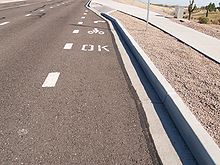 Pavement markings invite bicyclists to enter sidewalk on approach to roundabout in Mesa, Arizona. Bicyclists are still permitted to use the roundabout like any other vehicle.
Pavement markings invite bicyclists to enter sidewalk on approach to roundabout in Mesa, Arizona. Bicyclists are still permitted to use the roundabout like any other vehicle.
The roundabout at the Brown Road/202 interchange includes such a design.[35] On-street pavement markings indicate bicyclists may enter sidewalk at end of bike lane. Bicyclists who choose to travel on the wide sidewalk cross roundabout arms perpendicularly some distance removed from the circle. Each crossing crosses two lanes, one in each direction. A median refuge is provided to allow pedestrians and bicyclists to cross one lane at a time.
The reason for placing crossings away from the circle is to give motorists more space and time to yield to cyclists and pedestrians who cross in them, and to increase the likelihood that crosswalk users and motorists will see each other.
Bicycle-pedestrian roundabouts
The same features that make roundabouts an attractive option for roadway junctions have led to their use at junctions of multi-use trails. The University of California, Davis[36] and Stanford University both have built bicycle-pedestrian roundabouts. Roundabouts are used on off-road bicycle trails in Florida, Colorado and Alaska.[37]
See the United States DOT publication, Roundabouts: An Informational Guide.
Advantages of roundabouts
- Roundabouts are safer than signal controlled junctions,[38] with accidents usually occurring at a slower speed and at a slight angle instead of right-angle or rear end collisions at junctions.
- Roundabouts allow U-turns within the normal flow of traffic, which are often not possible at other forms of junction.
- In general, roundabouts substantially reduce congestion and delays as vehicles are not required to perform a complete stop.
- Compared to intersections, Roundabout operate more efficiently and thus reduce delays and congestion as they are not at the whim of an artificially induced delay by traffic signals. Efficiency is gained by a direct response from the driver to the traffic conditions without any restrictions set by traffic signals - i.e. drivers can proceed when traffic is clear without the delay incurred by a traffic signal.
Public opinion
In the United States, municipalities introducing new roundabouts often are met with some degree of public resistance just as in the United Kingdom in the 1960s. Drivers may be unfamiliar with roundabouts initially; however, surveys show that public opinion improves as drivers gain more experience with roundabouts. A 1998 survey of municipalities that built roundabouts found public opinion prior to construction as 68% opposed; afterwards it was 73% in favour.[39] A 2007 survey of citizens found public support at 22% to 44% prior to construction, and several years after it was 57% to 87%.[40]
Special types
Large roundabouts such as those used at motorway junctions typically have two to six lanes around the central hub, and may have traffic lights regulating flow.
Some roundabouts have a divider between traffic turning from one road onto an adjacent one, and traffic within the roundabout, enabling those making such turns to bypass the roundabout entirely.
Gyratory system
The term "gyratory" (for example, Hanger Lane gyratory) is sometimes used in the United Kingdom when a roundabout is large and has non-standard lane markings or priorities, or when there are buildings on the central island; in fact, they are more like traffic circles.[41]
Mini-roundabouts
After developing the offside priority rule, Frank Blackmore, of the UK's Transport Research Laboratory, turned his attention to the possibility of a new type of roundabout that could be utilised at sites with limited space to use a conventional roundabout.
Mini-roundabouts exist at these smaller junctions to avoid the use of signals, stop signs or the necessity to give way in favour of one road of traffic. Mini-roundabouts can be a painted circle or a low dome but must be fully traversable. Painted roundabouts and low domes can easily be driven over by most vehicles, which many motorists will do when there is no other traffic, but the practice is dangerous if other cars are present. Mini-roundabouts work in the same way as larger roundabouts in terms of right of way but can give different performance with regard to driver behaviour. Mini-roundabouts are sometimes grouped in pairs (a double mini-roundabout) or in "chains", making navigation of otherwise awkward junctions easier. In some countries there are different road signs used to distinguish mini roundabouts from larger ones.
Mini-roundabouts are common in the UK and Ireland, as well as Irapuato in Mexico and Mount Royal and Rosedale in Calgary, Canada. Kemptville, Ontario, a small town located in Canada, has the record for the most roundabouts in Ontario, with a record of three on one highway. Most people who do not live in Kemptville find it difficult to use the roundabouts properly. This is the leading source of road rage in Kemptville.
A slightly larger version of a mini-roundabout, sometimes called a "small or midi roundabout", is designed with a raised centre surrounded by a sloped "overrun area" of a different colour from the roadway and up to a metre wide called a "truck apron" or a "mountable apron". The truck apron's design discourages small vehicles from taking a shortcut over it while at the same time allowing the mini-roundabout to more easily accommodate the turning radius of larger vehicles (such as a truck which may have to navigate the roundabout).
In the UK the maximum permissible diameter of the central painted circle of a mini-roundabout is 4m. Whilst it may be physically possible, it is illegal for vehicles which are able to circulate around the central circle of the roundabout to go over the painted circle, or around the wrong way. Vehicles should treat the painted circle like a solid island and proceed around it.[42] (In practice, many motorists ignore these rules, especially when traffic is light.)[citation needed] Some local authorities have installed double white lines around the painted circle to indicate this, but these are not permitted under UK traffic signs regulations without authorisation from the Secretary of State for Transport . The centre island also must be able to be over-run by larger vehicles.
At Hatton Cross roundabout, close to London Heathrow Airport, five small ‘mini-roundabouts’ have been constructed where the roads join/leave the main roundabout, allowing traffic to circle the main roundabout in both directions - clockwise in the outer lane(s) and anti-clockwise in the inner lanes.
Raindrop roundabouts
These roundabouts do not form a complete circle and are in a "raindrop" shape. They are appearing at U.S. Interstate interchanges to provide a free-flowing left turn to the on-ramps and eliminating the need for turn signals and lanes. Since the entry and exit slip roads are one-way, a complete circle is unnecessary. This means that drivers entering the roundabout from the bridge do not need to give way and prevents queuing on narrow, two-lane bridges. These roundabouts have been used at dumbbell roundabout junctions, replacing traffic signals that are inefficient without a turning lane. Several junctions along Interstate 70 near Avon, Colorado use teardrop roundabouts.[43]
Turbo roundabouts
In the Netherlands and Belgium, a relatively new type of roundabout is built increasingly often. It provides a forced spiralling flow of traffic, thus requiring motorists to choose their direction before entering the roundabout. By eliminating many conflicting paths and choices on the roundabout itself, traffic safety is increased, as well as speed, and as a result, capacity. A turbo roundabout does not allow travelling a full circle.
Several variations of the turbo roundabout exist. The basic turbo roundabout shape is designed for where a major road crosses a road with less traffic.
Turbo roundabouts were originally built with raised lane separators. Newer implementations with only lane markings exist, for efficiency (regarding safety, speed and capacity) of the design by reducing safety risk to large and small vehicles and enabling maintenance such as snow ploughs. Similar roundabouts, with spiralling lane markings, have been used for many years in the UK e.g. the A176/A127 (eastbound) at Basildon, Essex.
According to micro-simulation, a two-lane roundabout with free right turns should offer 12-20% greater traffic flow than a conventional, three-lane roundabout of the same size. The reason offered by authors Ir. Isaak Yperman and Prof. Ir. Ben Immers is that there is less weaving in a turbo, making entering and exiting more predictable. Because there are only ten points of conflict (compared with 8 for a conventional single lane roundabout, or between 32 and 64 with traffic signal control), it is often expected that this design is safer, as well. At least 70 have been built in the Netherlands, while many turbos (or similar, lane splitting designs) can be found in southeast Asia.[44]
Multi-lane roundabouts in the United States of America are typically required to be striped with spiral markings,[45] as most states follow the federal Manual on Uniform Traffic Control Devices or develop a state-level manual subject to the approval of the federal government.
Roundabouts on motorways
Roundabouts are generally not appropriate for placement on motorway or freeway mainlines because the purpose of such facilities is to provide for uninterrupted traffic flow. However, roundabouts are often used for the junction between the slip roads and the intersecting road. A single roundabout, grade separated from the mainlines, may be used to create a roundabout interchange. This type of junction is common in the UK and Ireland. Alternatively, separate roundabouts may also be used at the slip road intersections of a diamond interchange to create what is often referred to as a "dumbbell interchange", which is increasingly common in both Europe and North America due to its reduced need for wide or multiple bridges.
An additional use of roundabouts for junctions is the 3-level stacked roundabout — this is a roundabout interchange where both of the roadway mainlines are grade separated. In the United Kingdom, the M25/A3, M8/M73 and A1(M)/M18 interchanges are examples of this type. These junctions, however, have less capacity than a full free-flow interchange. A similar design to this is the three-level diamond interchange.
Most junctions on Dublin's M50 motorway C-road use a standard roundabout interchange — although several such junctions have a greater volume of traffic than the capacity such roundabouts can accommodate. In Northern Ireland, the junction between the M1 and M12 (Craigavon connector motorway) is via a standard roundabout with a raised centre, 3 onslips and 3 offslips, and 2 lanes.
In the city of Malmö, Sweden, there is a roundabout connecting two motorways, Autostradan from Lund, and the Inner ring road. It is signposted as a motorway throughout this roundabout. Today these two motorways are considered local, but before the year 2000 they were part of the European roads E6, E20 and E22.
In the Netherlands, A6 motorway and A7 motorway cross near Joure using a roundabout. For the junction between the A200 and the A9 a 3-level stacked roundabout is used. Near Eindhoven (the Leenderheide junction), the junction for the A2 is done with a roundabout. An overpass is built for the A67 from Antwerp to Germany.
Roundabout interchanges are sometimes confused with rotary interchanges, which operate with traffic circles rather than roundabouts. Rotary interchanges are common in New England, particularly in the state of Massachusetts, but a European example of a rotary interchange may be found in Hinwil, Switzerland.
Controlled roundabouts
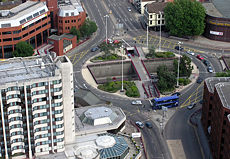 A major signal-controlled roundabout interchange in central Bristol, England. Vehicles drive on the left, and vehicles in the roundabout are stopped by traffic lights to allow other vehicles to enter, while an underpass permits straight-through traffic to bypass the roundabout entirely.
A major signal-controlled roundabout interchange in central Bristol, England. Vehicles drive on the left, and vehicles in the roundabout are stopped by traffic lights to allow other vehicles to enter, while an underpass permits straight-through traffic to bypass the roundabout entirely.
Some bridges on Beijing's 2nd Ring Road are controlled by traffic lights. While it may appear to defy the roundabout system at first, it works well to control the flow of traffic on the bridges, which themselves are two viaducts creating a roundabout suspended over the ring road itself.
Signal controlled roundabouts are common in Great Britain and Ireland, where they have been introduced in an attempt to alleviate traffic problems at over-capacity roundabout junctions or to prevent some flows of traffic dominating others (around the M50 in Dublin for example).
"Magic" roundabouts
The town of Swindon in Wiltshire, England, is known for its "Magic Roundabout". This roundabout is at a junction of five roads and consists of a two-way road around the central island with five mini-roundabouts where it meets the incoming roads. Traffic may proceed around the main roundabout either clockwise via the outer lanes, or anticlockwise using the inner lanes next to the central island. At each mini-roundabout the usual clockwise flow applies.
Similar systems are found in various places in England, most famously the Moor End roundabout in Hemel Hempstead (Hertfordshire), which has six intersections; but also in High Wycombe (Buckinghamshire),[46] the Denham Roundabout in Denham (Buckinghamshire), the Greenstead Roundabout in Colchester (Essex), the Sadlers Farm Roundabout in Benfleet (Essex) which is the junction between the A130, the A13 and the B1464 (although this is currently being converted to a signal-controlled roundabout, with work expected to be completed by early 2012[47]), "The Egg" in Tamworth (Staffordshire) and the Hatton Cross Roundabout in London.[48] Magic roundabouts are also known as "Ring Junctions"
Roundabouts with trams
Tram roundabouts are found in many countries.
In inner Melbourne, particularly in the inner suburban area of South Melbourne, where the tram network is extensive, tram tracks always pass through the central island of these roundabouts, with drivers required to give way, not only to vehicles coming towards them from their right, but also to trams coming at them from right-angles.
Having trams pass through small roundabouts is not a problem; through larger roundabouts it can be difficult, particularly when there is a junction between tram lines as well. In these cases, the roundabouts are very large, and often have tram stops in the middle. The Haymarket roundabout between Royal Parade and Elizabeth Street is the most notorious junction of this nature, containing a tram-stop, pedestrian crossings, three entering tram lines, traffic signals to stop vehicular traffic at each crossing point when a tram is due, service roads and pedestrian crossing.
In Brussels, Belgium, trams treat roundabouts in various ways: at the Barrière de St-Gilles/Bareel St-Gillis, the tram tracks form a circle in the carriageway, while Verboekhoven and Altitude Cent/Hoogte Honderd have reserved tram tracks on the inside of the roundabout. At Place Stéphanie/Stefaniaplein, they go straight through the middle, with a slip track up the Chaussée de Charleroi/Charleroisesteenweg.
In Dublin, Ireland, the Red Cow interchange at the N7/M50 junction is particularly infamous. It is a grade-separated motorway junction, and is signal-controlled with secondary lanes (separate from the main roundabout) for those making left turns. The junction, the busiest in Ireland, had tram lines added to it with the opening of the Luas system in 2004. The tracks pass across one carriageway of the N7, and across the southern M50 sliproads. Trams pass at a frequency of every 5 minutes at rush hour. The roundabout has been replaced with grade separated free flowing junction.
In Gothenburg, Sweden the roundabout and tram stop at Korsvägen (the Crossroad) is of this type, and is rather infamous in the city. It is heavily trafficked by cars, and about one tram or bus per minute passes in several directions. This is further complicated by separated rights-of-way for trams and buses and the fact that it is also one of the busiest interchanges in the city. Another one is located at Mariaplan in the inner suburb of Majorna. The trams makes a right turn, giving the roundabout an odd design. Since traffic isn't heavy, this normally doesn't create any problems.
In Warsaw, trams typically cross straight through roundabouts, and have junctions in the middle of them. In Wrocław, Poland, trams pass through the Powstańców Śląskich Roundabout, having a stop in the roundabout (north-headed track).
In Vítězné náměstí (Victory Square) in Prague, Czech Republic, a tramway crosses the carriage way of the roundabout at 3 places since 1942. Entering as well as leaving trams have to give way to all cars. In years 1932–1942 trams went around much like cars.[49]
In Kiev, Ukraine an interchange of two "fast tram" lines is done below a roundabout.
Oslo, Norway also has many roundabouts with tram tracks passing through; for example at Bislett, Frogner plass, Sinsen, Solli plass, Carl Berners plass and Storo.
In Wolverhampton, England, the Midland Metro tram passes through the centre of a roundabout on approach to its terminus at St Georges. This also happens in New Addington on the Tramlink on Old Lodge Lane at the junction to King Henry's Drive.
In Salt Lake City, Utah a light rail line on the south side of the University of Utah crosses a roundabout where Guardsman Way meets South Campus Drive. Like virtually all rail crossings in the United States, both crossings in the circle are equipped with boom barriers.
In Kassel, Germany, the tram line serving Lines 4 and 8 passes through the middle of the roundabout at Platz der Deutschen Einheit. The tram stops are in the middle of the roundabout. To allow trams through, traffic is controlled by lights on the roundabout. Pedestrian access is via subway and street level crossings at the traffic lights for the trams.
Roundabouts with railways
In Jensen Beach, Florida, the main line of the Florida East Coast Railway running north-south bisects the two-lane roundabout at the junction of Jensen Beach Boulevard running east-west and three other roads and the service entrance to a large shopping plaza. Boom barriers are in place at the railway crossings. The landscaped centre island bisected by the tracks was originally curbed, but 18-wheelers had trouble negotiating the roundabout, so the curbs were replaced with painted drive over concrete strips. A proposed fountain in the centre island has never been built. The roundabout was built in the early 2000s and has improved traffic flow considerably although there are still delays caused by the many long freight trains coming through.[50]
Two roundabouts in the Melbourne metropolitan area, Highett, Victoria[51] and Brighton,[52] have heavy rail crossing the roundabout and through the inner circle. Boom barriers protect the rail from oncoming traffic at the appropriate points in the roundabout.
At the Driescher Kreisel[53] in Bergisch Gladbach, Germany, a railway serving a nearby paper factory crosses a roundabout, which is located next to a shopping centre and pedestrian zone. The flow of traffic and pedestrians is governed by 14 barriers, 22 traffic lights and 8 loudspeakers. The barriers are closed three times a day for 7 minutes to allow trains to pass.
Hamburger roundabout/throughabout/cut-through roundabout
These resemble a normal roundabout but are signalised and have a straight-through section of carriageway for one of the major routes. The hamburger name derives from the fact that the plan view resembles the cross-section through a hamburger. There are examples on the A580 East Lancashire Road in St Helens, England, on Haydock Island in Merseyside (which also features the M6 passing overhead), and on the Astley/Boothstown border near to Manchester. More examples are the A6003 at Kettering, the A538 near Manchester Airport, the "Showcase" junction on A329 at Winnersh, Berkshire.[54] and the A63/A1079 Mytongate junction in Hull. Examples also exist in Bracknell, Hull,[55] Nottingham and Reading (all in England), as well as on the N2/M50 intersection in Dublin, Ireland.
A more advanced and safer version of a hamburger roundabout is a roundabout interchange, separating the straight roadway and using underpasses or overpasses to cross the roundabout itself.
See also
References
- ^ a b The New Shorter Oxford English Dictionary, Volume 2, Clarendon Press, Oxford (1993), page 2632
- ^ U.S. Department of Transportation: Roundabouts: an Informational Guide para 1.5
- ^ BBC News (2 November 2004). "Roundabout Magic". http://news.bbc.co.uk/1/hi/magazine/3972979.stm. Retrieved 13 May 2007.
- ^ Letchworth Garden City Heritage Foundation. "Sign of the Times". Archived from the original on 16 October 2006. http://web.archive.org/web/20061016113507/http://www.letchworthgc.com/cgi-bin/news_fullstory.cgi?newsid=72. Retrieved 14 December 2006.
- ^ maps.google.com
- ^ a b Keh, Andreh (November 18, 2010). "European Import Has Cars Spinning. Heads, Too.". New York Times. http://www.nytimes.com/2010/11/19/us/19roundabouts.html. Retrieved 19 November 2010.
- ^ a b c tfhrc.gov/safety
- ^ American Heritage ("roundabout: Chiefly British A traffic circle."), Random House ("roundabout: Chiefly Brit. See traffic circle.") , Merriam-Webster ("roundabout, noun: British : rotary 2"; "rotary 2 : a road junction formed around a central circle about which traffic moves in one direction only —called also circle, traffic circle) Macmillan "roundabout: a circular area where three or more roads meet that you have to drive around in one direction in order to get onto another road. The American word is traffic circle or rotary."), Cambridge ("roundabout: UK (US traffic circle)), Concise Oxford (rotary: N. Amer. a traffic roundabout.)
- ^ trb.org
- ^ Shashi S. Nambisan, Venu Parimi (March 2007). "A Comparative Evaluation of the Safety Performance of Roundabouts and Traditional Intersection Controls". Institute of Transportation Engineers.
- ^ 2008 National Roundabout Conference, B. Guichet's presentation
- ^ alaskaroundabouts.com
- ^ fhwa.dot.gov U.S. Department of Transportation: Roundabouts: an Informational Guide para 1.5
- ^ Kittleson & Associates. "Kansas Roundabout Guide: A Supplement to FHWA's Roundabouts: An Informational Guide". Kansas Department of Transportation. http://www.ksdot.org/burtrafficeng/Roundabouts/Roundabout_Guide/Chapter_6_Geometric_Design.pdf. Retrieved 26 August 2009.
- ^ state.nj.us
- ^ Capuzzo, Jill P. (25 November 2007). "A Shift, but for Some Drivers, a Vicious Circle". The New York Times. http://www.nytimes.com/2007/11/25/nyregion/nyregionspecial2/25circlesnj.html?ref=automobiles. Retrieved 27 March 2010.
- ^ American Heritage ("roundabout: Chiefly British A traffic circle."), Random House ("roundabout: Chiefly Brit. See traffic circle.") , Merriam-Webster ("roundabout, noun: British : rotary 2"; "rotary 2 : a road junction formed around a central circle about which traffic moves in one direction only —called also circle, traffic circle) Macmillan "roundabout: a circular area where three or more roads meet that you have to drive around in one direction in order to get onto another road. The American word is traffic circle or rotary."), Cambridge ("roundabout: UK (US traffic circle)), Concise Oxford (rotary: N. Amer. a traffic roundabout.)
- ^ "Frank Blackmore: traffic engineer and inventor of the mini-roundabout". The Times (London). 14 June 2008. http://www.timesonline.co.uk/tol/comment/obituaries/article4131930.ece. Retrieved 15 June 2008.
- ^ a b Tom Geoghegan (2011-07-01). "Is the British roundabout conquering the US?". BBC website. http://www.bbc.co.uk/news/magazine-13863498. Retrieved 2011-07-01.
- ^ Dayna Roselli, "Roundabouts", on lasvegasnow.com, April 18th, 2007
- ^ Tom, Geoghegan (1 July 2011). "Is the British roundabout conquering the US?". BBC News. http://www.bbc.co.uk/news/magazine-13863498. Retrieved 4 July 2011.
- ^ engineering.purdue.edu
- ^ iihs.org
- ^ Richtmeyer, Richard (6 January 2008). "Safer Roundabouts Sprouting Up All Over New York, Nation". Associated Press. http://www.boston.com/news/local/connecticut/articles/2008/01/06/safer_roundabouts_sprouting_up_all_over_new_york_nation/. Retrieved 10 January 2008.
- ^ Wilke, A. and Koorey, G. (2001). How Safe are Roundabouts for Cyclists? In TranSafe Issue 5, April 2001. Wellington, NZ. PDF
- ^ "Crash analysis system". http://www.landtransport.govt.nz/research/cas/. Retrieved 29 November 2007.
- ^ Campbell, D., Jurisich, I., Dunn, R. 2006. Improved multi-lane roundabout designs for cyclists. Land Transport New Zealand Research Report 287. 140 pp. PDF
- ^ Pedestrian Access to Modern Roundabouts: Design and Operational Issues for Pedestrians who are Blind retrieved 6/26/2010 access-board.gov
- ^ Bill Baranowski, P.E., Pedestrian Crosswalk Signals at Roundabouts: Where are they Applicable? teachamerica.com
- ^ a b c Modern Roundabouts, an Informational Guide, tfhrc.gov/safety
- ^ US Manual on Uniform Traffic Control Devices, mutcd.fhwa.dot.gov
- ^ R. Schnüll, J. Lange, I. Fabian, M. Kölle, F. Schütte, D. Alrutz, H.W. Fechtel, J. Stellmacher-Hein, T. Brückner, H. Meyhöfer: Sicherung von Radfahrern an städtischen Knotenpunkten [Safeguarding bicyclists in Urban Intersections], Bericht der Bundesanstalt für Straßenwesen zum Forschungsprojekt 8952, 1992
- ^ bernd.sluka.de Scroll to the section labeled "Kreisverkehr". A translation of the text reads: Graphic from Sicherung von Radfahrern an städtischen Knotenpunkten [Safeguarding bicyclists in Urban Intersections], (BASt, 1992). Accident numbers in large circular junctions with different bicycle facilities show: 1. Why there should be no pathways or bike lanes at these junctions; 2. Even when bicyclists use the roadway, their risk is relatively high at these junctions.
- ^ Maycock, G., and Hall, R. D. (1984). "Accidents at 4-Arm Roundabouts." TRRL1120, Transport and Road Research Laboratory (TRRL), Crowthorne, England.
- ^ Arizona Department of Transportation roundabout information page
- ^ maps.google.com
- ^ Shaw, Jeffrey and Moler, Steve, Bicyclist- and Pedestrian-Only Roundabouts, Public Roads magazine, January/February 2009, tfhrc.gov
- ^ iihs.org
- ^ onlinepubs.trb.org
- ^ Retting, Richard A., Sergey Y. Kyrychenko, and Anne T. McCartt. "Long-Term Trends in Public Opinion Following Construction of Roundabouts." Journal of the Transportation Research Board 2019 (2007): 219-24.
- ^ "History of Roundabouts". http://www.alaskaroundabouts.com/history.html. Retrieved 29 November 2007.
- ^ "The Highway Code – Roundabouts". http://www.direct.gov.uk/en/TravelAndTransport/Highwaycode/DG_070338. Retrieved 14 May 2009. Section 188, referring to Road Traffic Act 1988, Section 36, and Traffic Signs Regulations & General Directions 2002, Regulations 10(1) & 16(1)
- ^ Google Maps view of a teardrop roundabout
- ^ kuleuven.be
- ^ mutcd.fhwa.dot.gov
- ^ maps.google.co.uk
- ^ http://www.essex.gov.uk/Environment%20Planning/Planning/Transport-planning/Travel-improvements/Pages/A13-A130-Sadlers-Farm-Junction.aspx
- ^ maps.google.co.uk
- ^ Vítězné náměstí, Prague trams fun web
- ^ Jensen Beach Roundabouts Charrette
- ^ street-directory.com.au
- ^ street-directory.com.au
- ^ bergischgladbach.de
- ^ maps.google.co.uk
- ^ maps.google.co.uk, Mytongate on the A63 in Hull
External links
- TRL, The UK's Transport research Laboratory
- Modern Roundabouts - Geocoded National Database
- Mini-roundabouts - Getting them Right
- Turbo Roundabout Simulation
Categories:- Road junction types
- Roundabouts
- Utility cycling
- Cycling safety
Wikimedia Foundation. 2010.

